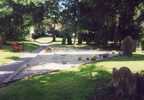For this church:    |
Woodborough St SwithunChurchyard
Visitation reports from 1870 onwards show that the church graveyard was considered full. It was some time before negotiations commenced for a new cemetery, but it was decided on 18th August 1878 that the church graveyard would be closed to further burials from 31st December 1878. There was an exception in that burials could continue to take place in existing walled graves. The last person to be buried in the church graveyard itself was Mansfield Parkyns who died in January 1894 only a matter of days after seeing his choir stall carvings dedicated in the chancel, as recorded on a brass tablet next to the pulpit. One distinctive headstone near the porch and tower is a tall pointed slab marking the graves of the Oldacres, curates and schoolmasters. It is said that a pointed slab was used to deter children from sitting on their former masters! A Garden of Rembrance to mark cremations was created in 1980 near the East window and resurfaced with gravel and edging stones in 1990. Parish CemeteryIt was finally agreed that one acre of glebe land in Moor Field be purchased from the then incumbent, the Rev Mr Slight. The plot of land is at the top of Roe Hill and when opened in January 1879 it decided that the site should be divided equally through the middle by a four-foot gravelled pathway, with Dissenters to be buried in the south side and church people in the north side. Records noted that: Mr Richard Ward, a local joiner, to fence with three year old quick and plants of privet. Woodborough cemetery is in a peaceful spot on the top of the hill but it is a steep climb for some. At one time horses were used to pull a strange vehicle, forepart hearse and rear part carriage, known as a Shillibeer (after its inventor) to convey mourners and the coffin up the hill. Mr Ward built a type of lych gate building in 1879 which also housed the ‘Shillibeer’ when not in use. There appears to be no record of when the Shillibeer ceased to be used but the lychgate building was demolished in about 1970 and replaced by wrought iron gates. For further information see the Woodborough Heritage website. |







